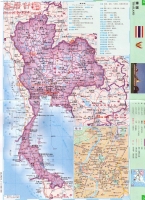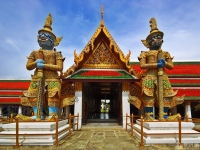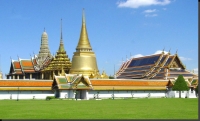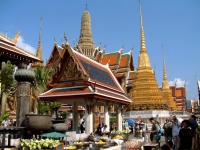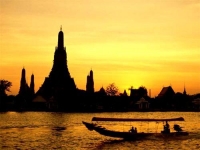东南亚:
|
| 泰国 Thailand 首都:曼谷 国家代码: th |
|
泰王国(The Kingdom of Thailand)。简称泰国(Thailand,Thai)是东南亚的一个国家,东临老挝和柬埔寨,南面是暹罗湾和马来西亚,西接缅甸和安达曼海。在1949年5月11日以前,泰国的名称是暹罗。
国旗 呈长方形、长与宽之比为3∶2。由红、白、蓝三色的五个横长方形平行排列构成。上下方为红色,蓝色居中,蓝色上下方为白色。蓝色宽度相等于两个红色或两个白色长方形的宽度。红色代表民族和象征各族人民的力量与献身精神。泰国以佛教为国教,白色代表宗教,象征宗教的纯洁。泰国是君主立宪政体国家,国王是至高无上的,蓝色代表王室。蓝色居中象征王室在各族人民和纯洁的宗教之中。 国徽 泰国国徽是一个极富宗教神秘色彩的图腾图案。深红色的大鹏是泰国民间传说中鹰面人身的神灵。 国花 稻花(禾本科) 语言 泰语是泰国的官方语言。属壮侗语系侗台语族。泰语是一种分析型语言,不同的声调有区分词汇和语法的作用。 泰语与台语 泰语与台语都是从英语的Thai翻译而来。英语的Thai可以指一个语言,也可以指一组语言。一般来说,在以中文写就的文章中,表示一个语言时写作泰语,表示包含泰语在内的一组语言时写作台语。 货币 铢(baht)符号:THB 宗教 佛教为国教,其信徒占95%,其次伊斯兰教占3.8%,基督教占0.5%,其他0.7%。 面积 513,115平方公里(世界第49名) 人口 总人口:65,444,371(世界第19名) 人口密度:127/km2(世界第59名) 民族 全国共有30多个民族。泰族为主要民族,占人口总数的40%,其余为老挝族,华族,马来族,高棉族,和苗、瑶、桂、汶、克伦、掸、塞芒、沙盖等山地民族。泰语为国语。94%的居民信仰佛教,马来族信奉伊斯兰教,还有少数信奉基督教、天主教、印度教和锡克教。 首都 曼谷(Bangkok),注册人口584万(2006年12月)。 国家元首 国王普密蓬·阿杜德(BHUMIBOL ADULYADEJ),拉玛九世王。1946年6月9日即位,1950年5月5日加冕。 国际电话区号 66 国际域名缩写 TH 政体 泰王国宪法规定:泰王国是以国王为国家元首的民主体制国家。 重要节日 宋干节(公历四月十三日至十五日);水灯节(泰历十二月十五日);国庆日(国王诞辰日,公历十二月五日)。 简况 位于中南半岛中南部。与柬埔寨、老挝、缅甸、马来西亚接壤,东南临泰国湾(太平洋),西南濒安达曼海(印度洋)。热带季风气候。全年分为热、雨、凉三季。年均气温24~30℃。 1238年开始形成较为统一的国家。先后经历了素可泰王朝、大城王朝、吞武里王朝和曼谷王朝。原名暹罗。16世纪,葡萄牙、荷兰、英国、法国等殖民主义者先后入侵。1896年英法签订条约,规定暹罗为英属缅甸和法属印度支那间的缓冲国。暹罗成为东南亚唯一没有沦为殖民地的国家。19世纪末,拉玛四世王开始实行对外开放。五世王借鉴西方经验进行社会改革。1932年6月,拉玛七世王时期,民党发动政变,改君主专制为君主立宪。1939年更名泰国,后经几次更改,1949年正式定名泰国。 同北京时差 比格林尼治时间早7小时;比北京时间晚1小时 【地理】 国境大部份为低缓的山地和高原。地形多变,可分为西﹑中﹑东﹑南四个部份。 泰国西部为山区,是喜玛拉雅山脉的延伸他念他翁山脉为主的山地,一直由北向南走向。位于清迈府的英坦昂峰(海拔2,576米)是泰国的最高峰。 东北部是呵叻高原,这里夏季极干旱,雨季非常泥泞,不宜耕作。中部是昭披那河(即湄南河)平原。由曼谷向北,地势逐步缓升,湄南河沿岸土地丰饶,是泰国主要农产地。曼谷以南为暹罗湾红树林地域,涨潮时没入水中,退潮后成为红树林沼泽地。泰国南部是西部山脉的延续,山脉再向南形成马来半岛,最狭处称为克拉地峡。 另外,泰国的一般大众习惯将国家的疆域比作大象的头部,将北部视为“象冠”,东北地方代表“象耳”,暹罗湾代表“象口”,而南方的狭长地带则代表了“象鼻”。 气候方面,泰国属于热带季风气候。常年温度不下摄氏18℃,平均年降水量约1000毫米。11月至2月受较凉的东北季候风影响比较干燥,3月到5月气温最高,可达摄氏40-42℃,7月至9月受西南季候风影响,是雨季。10月至12月偶有热带气旋从南中国海经过中南半岛吹袭泰国东部,但在暹罗湾形成的热带气旋为数甚少且弱。 【历史】 泰国目前之地方,于几千年前即有人居住,但并不是泰族。据一般的了解,泰族是发源于中国的南部,而于公元第十一与十二世纪才移居到目前的泰国。 考古学家在泰国东北部的曼清发现许多古老的遗迹,证明泰国的文化起源于大约五千年前的青铜文化期。史前正确的资料至目前仍然不明,因为泰国的风俗和残存的文化一直在变动,而且很少记载下来,尤其在第十八世纪,由于受到外族的侵略而毁了不少早期的文物。 公元第十三世纪末,泰国史上的第一位最英明的国王――盂莱大帝,就在目前泰国北部的清莱与清迈一带建立了一个繁荣的社会,当时所兴建的庙宇显示受到佛教很大的影响。一般而言,泰国除了受到印度佛教的影响外,盂族、高棉族对泰国的影响也不小。泰国最大的民族是泰族,这些住在北部的民族,早期已能够自给自足,但他们的军事力量都相当薄弱,在公元十三世纪初,终被邻国吴哥王朝的高棉族所征服,不过,这段人侵时间并不长,泰族在1238年打了一次胜仗,从高棉人手中夺回素可泰城,并建立起泰国历史上的第一个王朝,定都素可泰。 素可泰在巴利文里的意思是“幸福的黎明”。当时,泰国还没有统一的文字,因此用“素可泰”作为第一个王朝的年号,以表明新时期的开始。素可泰王朝的君主为兰甘杏大帝,他被泰国人尊称为“泰国之父”。其最大的贡献,是将国内通行的真腊(即高棉)文字,改创成泰国自己的文字。约在1283年,泰文开始在全国流行。兰甘杏大帝受人尊重的另一原因,是他团结各族,以平等方式对待泰族以外的少数民族如高棉人、马来人和华人。他本身亦崇尚佛教,并派信徒到锡兰(今斯里兰卡)学习佛经,让他们回国后宣扬小乘佛教教义。素可泰王朝建立后,国泰民安,其势力开始向湄南河盆地流域扩展。到公元十四世妃初期,素可泰王朝的势力,已经影响整个马来半岛和老挝(即辽国)一带。兰甘杏去世后,强盛一时的王朝逐渐衰弱下去。此时,泰团东部的一股泰族势力,正在日益肚大,很快蔓延到中部地区。 1347年,一名太守的女婿拉玛铁菩堤,结集兵力在湄南河和巴塞河的汇合地方,建立了一座新城,取名阿育他耶(华人称之为大城),并立号为王,这就是后来的大城王朝。拉玛铁菩堤称王后,立即展开外交和军事攻势,有意占领整个湄南河流域,包括北部的素可泰王朝。他的精明思想和治国才能,为大城王朝的基业奠定了基础,且取代了素可泰王朝的地位。大城王朝维持了四百多年,经历三十三位君主。十五世纪末,绕非洲好望角至东方之航线开辟后,欧洲人开始前往泰国通商。首先到来的是葡萄牙人,他们占领了马六甲一带后,于1512年抵达大城。从此,荷兰人、英国人和法国人亦相继而来,企图在泰国这块富饶土地上获得利益。此外,泰国与邻国缅甸在这一时期经常发生冲突,持续了一段很长时间。 1767年,缅军再次攻入大城,城内的王宫、佛寺、民房和艺术宝藏均被摧毁。昔日的辉煌殿阁,如今只存残垣断壁,荒草遍地,谨供游人凭吊而已。大城王朝的京城在1767年陷落后,缅军仍留下士兵驻守,以镇压泰国人的反抗。但在泰国东南沿海一带,却崛起了一支抗缅部队,这支部队的主将原是大城王朝的将领郑信(在中国史书称郑昭)。郑信是华人后裔,其父郑镛原籍广东澄海,由于家贫才往泰国谋生,并与一泰族女子结婚,于1734年诞下郑信。郑信当日在大城被侵时,率领随从逃出大城,于泰国东南的罗勇府建立基地,组织力量,半年后部队分乘战船,沿湄南河而上,首先攻破了西岸吞武里,继而乘胜追击,到大城与腼军展开血战,最后终于收复渝陷的大城。郑信进城,目睹昔日首都大城只留下一片焦土,故决定迁都湄南河西岸的吞武里,建立起泰国的第三涸王朝一吞武里王朝,并削减了据地称雄的其他势力,收复失地,统一泰国。然而,宫廷内部的争权夺利,很快又再次出现。郑信在执政后期传说因妃嫔争宠而精神错乱,并于1782年一次倒戈事件中被杀。另一说称郑信被乱党困于宫中,后死在囚中,时为四十八岁。吞武里王朝就此覆灭,为时只有十五年。后人为纪念郑王的丰功伟绩,特在吞武里区域内建立郑王庙,并在大罗斗圈广场中央为郑倩塑造了一座纪念碑,碑上耸立着郑信的骑马戎装铜像,策马挥剑,极之英武。每年12月28日即郑王加冕之日,循例在铜像地区举行郑王朝祭大典,并封锁附近公路,举行两昼夜的文娱活动。 郑信的王朝被推翻后,其手下部将昭披耶节基登上王位,他就是拉玛一世王(拉玛是取自泰族民间傅说的一位英雄人物),也就是目前泰国的王朝,即当今皇上蒲美蓬大帝(拉玛九世王)之先祖。由于地方太小,加上国防上的理由,拉玛一世王把国都从吞武里移到昭拍耶河东岸,于是曼谷就成了泰国史上的第四个国都。至此泰国开始得到安定,曼谷王朝或称节基王朝或拉玛王朝至今已逾二百多年,而国都仍然是曼谷。 拉玛二世王,1809年登基,在位十五年,曾遣使赴北京二次,时为清朝道光及嘉庆年间。拉玛三世王(在位公元1824至1851年)开始又对西洋各国开放,甚至当时美国也派了首任官员出使泰国,接著美国的传教士也来了,他们同时也带来了印刷术,经过改良后使泰国开始有了泰文的印刷,另西欧医学、造船学也传人了泰国。拉玛四世王蒙库是节基王朝的英明国王之一,是泰国历史上第一位接受西方学术思想的国君,精佛学,重科学,知识广博。他通晓许多语言。如拉丁文、英文等。他是第一个准许平民可以亲近的国王。为了抵抗西方国家的侵人,他与邻国化干戈为玉帛,又与西方国家建立外交关系。他曾写信给美国南北战争时期的林肯总统,声明以物质支援他。王位传到拉玛五世王,也就是泰国史上最著名的朱拉隆功大帝,他从事大力的改革和积极的建设。他废除奴隶制度,兴建学校、博物馆、国立图书馆,并在国内修建了第一条铁路,发展道路系统,创办邮电局和其他现代化设施。历史学家称他的执政时期为“维新时代”,实际上可说是泰国现代化的开端。他是引导泰国现代化的英明国王,在位直到公元1910年。朱拉隆功于1910年逝世,后人为纪念他的功绩,在曼谷国会大厦前的广场摆放他的铜像。每年10月23日他的祭辰之日,此广场都有纪念活动举行。朱拉隆功去世之后,英、法便在泰国各自割分势力范围。由于拉玛六世王曾在英国剑桥求学,同时也曾服役于英军,所以第一次世界大战时,泰国就派兵到法国支援同盟国。大战结束后,暹罗也就加人了国际联盟。第一次大战以前’泰国人是只有名字而没有姓氏的。大战后拉玛六世王就宣布每个人可有姓,因此至今泰国人虽然有姓但很少用,而通常只叫名字。随著世界潮流之趋势,皇族的权力渐渐被宪法所限制,拉玛七位王执政后,结束了是达七百多年的君主专制,在1932年12月10日开始实行君主立宪,颁布宪法,于是泰国成了君主立宪的国家。由国会组织政府处理国家事务,一直至今。 第二次世界大战期间,1940年泰国为了保持国土的完整,勉强与日本签订友好条约,次年日本军队就进入泰国。泰国军民感到对日本抵抗并非上策,遂加入轴心国。战争结束,虽然轴心国(日本、德国等)失败,但泰国乃因“非原始发战国且没有出兵”而仍被邀加入联合国,目前泰国国内驻有联合国的分支机构。拉玛八世王,是五世王王子公摩銮宋卡王子之长公子。1934年继承王位,时因第二次世界大战起,随王太后驻跸瑞士,1945年回泰准备举行登基大典。不幸翌年6月9日中枪驾崩。年甘,在位12年。 当今王上拉玛九世王今年圣寿六秩晋九,1927年12月5日在美国麻省康毕城蒙奥本医院诞生,本生爵称蒲美蓬·亚偷耶益德亲王。1934年,拉玛七世王驻跸伦敦宣布逊位,因无所出,宫廷按谱立嗣君,奏请王兄继承大统,号称颂绿巴拉民他拉玛哈南他玛希隆陛下,简称拉玛八世王。1935年,当今王上以王上御弟身份加封昭华蒲美蓬亚伦耶益德王弟。1946年6月9日,拉玛八世王突告驾崩,当今王上以先王无嗣,按王族继承法规定宣布登基继承大统,号称拍昭裕华蒲美蓬?亚伦耶益德陛下,简称拉玛九世王。1950年,王上自国外回泰京都,三月钦命举行先王火葬御礼,同年四月甘八日赐定于十八涌宫殿举行大婚庆典,敕令册封诗丽吉?吉滴耶功女亲王为王后,号称颂缘拍拉·尼诗丽吉王后。1951年4月5日王后在瑞士洛桑之蒙瑞司医院院盆,诞生第一位公主,称号昭华鸟汶乐叻查干耶?诗丽越他那攀哇哩公主。1952年7月28日皇储太子诞生。1955年4月6日拍贴公主诞生。1957年7月4日朱拉蓬公主诞生。1956年10月22日王上剃度出家,皈依佛门,为期十五日,守戒于玉佛寺,政务方面敕命王后代为主政。还俗之后,鉴于王后秉政期间诸事有条不紊,循依古例敕封王后为正王后之位。溯自1946年,王上秉政以来,爱国爱民之圣怀,为国为民之圣务包罗万象,几乎日无稍懈,宣慰四方,视察民瘼,垂询当地官府军警详情,赐问各地民教卫生情况及生活实况。节基王朝第九世王蒲密蓬?阿伦耶勒陛下于1946年6月9日登基以来,至今已五十年,他是泰国有史以来在位世界最长的一位盛世明君。几十年来,王上以他超人的智慧,圣躬不屈不饶的毅力,为泰国的民主自由和繁荣进步建立了不朽的功绩。王上以坚定的决心,高度的热诚和德泽广被的亲和力,把全国经济地位不同、宗教信仰不同、种族背景不同的各民族人民团结成一体,朝向经济和社会建设的总目标。1996年6月9日是王上登基满五十周年之日,泰国全体臣民都以欢欣鼓舞的心情,热烈举行盛况空前的崇庆活勤,以颂扬王上登基五十周年的爱民若赤、圣泽广被和伟大仁政,表达全国万民感戴王恩浩荡的赤诚。 【政 治】 实行君主立宪制。国王普密蓬·阿杜德是国家元首、武装部队最高统帅。1946年6月9日继位,是当今世界在位最久的君主。 二战后,军人集团长期把持政权,局势动荡。上世纪90年代军人淡出政坛后,政坛党派林立,纷争不断,政府更迭频仍。 2001年,电讯业巨子塔信创建泰爱泰党,在大选中赢得下议院过半席位,组阁执政。2005年2月,泰爱泰党在大选中赢得下议院500个议的席中377席,塔信蝉联总理。 2005年9月起,泰社会掀起“反塔”运动,政局出现动荡。为缓解政治压力,塔信于2006年2月解散议会,提前举行下议院选举,政府转为看守内阁。泰爱泰党在4月的大选中再次赢得过半选票,但因三大反对党--民主党、泰国党、大众党抵制大选,导致国会无法在宪法规定时间内成立。5月8日,宪法法院裁定4月大选中存在违宪问题,宣布选举结果无效。9月19日,以陆军司令颂提为首的“行政改革委员会”发动军事政变,废除1997年宪法,解散国会、内阁,接管政权。10月1日,普密蓬国王御准临时宪法,任命原枢密院大臣素拉育·朱拉暖出任新总理,8日御准新内阁,12日御准立法议会,代行国会职责。政变发生后,他信旅居海外,宣布辞去泰爱泰党党首职务,退出政坛。2007年末,由他信亲信沙马·顺达卫领导的人民力量党在泰国大选中胜出,沙马·顺达卫成为泰国新任总理。 【宪 法】 现行宪法为临时宪法,于2006年10月1日获普密蓬国王御准颁布实施。分为国王、公民权利、自由与义务、议会、内阁、法院、新宪法制定、全国大选等39条。 【议 会】 全称立法议会。2006年9月19日,泰“行政改革委员会”发动军事政变,宣布暂时接管国家行政权力,废除1997年宪法,解散看守政府和国会。10月1日,普密蓬国王御准临时宪法。11日根据临时宪法任命242名立法议会议员,25日任命米猜·雷初攀为立法议会主席,乍兰·军拉瓦尼上将、普乍尼·塔纳瓦拉尼(女)为副主席。2007年末,由他信亲信沙马·顺达卫领导的人民力量党在泰国大选中胜出,沙马·顺达卫成为泰国新任总理(兼任防长),新一届36人内阁名单已由普密蓬国王批准通过。 立法议会现代行国会职责,下设24个专门委员会,主要负责审议制定有关法律文件,对政府政策和工作进行监督。立法议会主席兼任国民大会主席,有权任命200名制宪会议委员。 【政 府】 政府由一名总理和不超过35名部长组成。 现政府于2006年10月成立。34位阁员名单如下:总理素拉育·朱拉暖(Gen.Surayud Chulanont)、副总理科实·班扁叻(Mr.Kosit Punpiemrat)、副总理派汶·瓦塔纳西里他(Mr.Paiboon Wattanasiritham)、国务部长坤仁提帕瓦迪·梅莎宛(Kunying Dhipavadee Meksawan)、国务部长提拉帕·社里朗讪(Mr. Thirapat Serirangsan)、国务部长巴实·科威拉军(Mr. Prasit Kovilakool)、国防部长汶洛·颂塔上将(Gen. Boonrod Somtad)、财政部长察隆颇·素桑甘(Mr.Chalongphob Sussangkarn)、财政部副部长颂迈·帕实(Mr.Sommai Phasee)、外交部长尼特·披汶颂堪(Mr. Nitya Pibulsonggram)、外交部副部长雄威倪·孔诗里(Mr. Sawanit Kongsiri)、旅游和体育部长素威·耀玛尼(Mr. Suwit Yodmanee)、社会发展和人类安全部长派汶·瓦塔纳希里探(Mr. Paibool Wattanasiritham)、社会发展和人类安全部副部长蓬得·炳巴提(Mr.Poldej Pinprateep)、农业与合作部长提拉·素达布(Mr. Thira Sutabot)、农业与合作部副部长隆叻·伊沙朗军·纳·阿育他耶(Mr. Rungruang Isarangkura Na Ayuthaya)、交通部长提拉·浩乍仑上将(ADM. Thira Hao-Charoen)、交通部副部长讪盛·翁猜务(Mr. Sansern Wongcha-um)、自然资源和环境部长格森·沙尼翁·纳·阿育他耶(Mr. Kasem Sanitwong Na Ayuthaya)、信息技术和通讯部长西提猜·颇凯乌东(Mr. Sitthichai Pokai-udom)、商业部长格盖·吉拉派(Mr. Krirkkrai Jeerapath)、商业部副部长奥拉努·欧沙塔暖(Mrs.Oranuj Osatananda)、能源部长比亚沙瓦·阿玛拉南(Mr. Piyasvasti Amranand)、内政部长阿里·翁阿拉亚(Mr. Aree Wongsearaya)、内政部副部长班雅·占塞纳(Mr. Bunyat Junsena)、司法部长禅猜·里奇吉塔(Mr. Charnchai Likhitjitta)、劳工部长阿派·占塔纳尊格(Mr. Apai Chandanachulaka)、文化部长坤仁凯西·西阿伦(Khunying Khaisri Sri-aroon)、科技部长勇育·育塔翁(Prof.Dr. Yongyuth Yuthawongs)、教育部长威集·西沙安(Mr. Wijit Arisa-an)、教育部副部长瓦拉功·讪郭社(Mr.Varakron Samakses)、卫生部长蒙空·纳·宋卡(Mr. Mongkol Na Songkhla)、卫生部副部长莫拉哥·功格社(Mr.Morakot Kornkasem)、工业部长科实·班扁叻(Mr.Kosit Punpiemrat)、工业部副部长比亚布·春威占(Mr. Piyabutr Cholvijarn)。 【行政区划】 泰国全国共有76个一级行政区,其中包括75个“府”(changwat)与直辖市的首都——曼谷。这76个行政区一般被划分为5个主要地区,包括北部、东北部、东部、中部与南部地区,每个府都是以其首府(mueang)作为该府的命名。在府底下,又有更小的次级行政区划,称为“区”(amphoe)与“次区”(king amphoe),根据2000年时的统计,泰国全国共有795个区与81个次区。至于首都曼谷的次级行政区则与各府的次级行政区在命名上有点出入,称为“khet”总数达50个。 北部地区 清迈府(Chiang Mai) 清莱府(Chiang Rai) 甘烹碧府(Kamphaeng Phet) 南邦府(Lampang) 南奔府(Lamphun) 湄宏顺府(Mae Hong Son) 北榄坡府(Nakhon Sawan) 楠府(Nan) 拍天府(Phayao) 碧差汶府(Phetchabun) 披集府(Phichit) 彭世洛府(Phitsanulok) 帕府(Phrae) 素可泰府(Sukhothai) 来兴府(Tak) 乌泰他尼府(Uthai Thani) 程逸府(Uttaradit) 东北地区 安纳乍能府(Amnat Charoen) 武里喃府(Buriram) 猜也贲府(Chaiyaphum) 加拉信府(Kalasin) 坤敬府(Khon Kaen) 黎府(Loei) 吗哈沙拉堪府(Maha Sarakham) 莫拉限府(Mukdahan) 那空拍侬府(Nakhon Phanom) 呵叻府(Nakhon Ratchasima) 廊磨喃蒲府(Nong Bua Lamphu) 廊开府(Nong Khai) 横逸府(Roi Et) 色军府(Sakon Nakhon) 四色菊府(Si Sa Ket) 素辇府(Surin) 乌汶府(Ubon Ratchathani) 莫肯府(Udon Thani) 益梭通府(Yasothon) 东部地区 北柳府(Chachoengsao) 尖竹汶府(Chanthaburi) 春武里府(Chon Buri) 巴真府(Prachin Buri) 罗勇府(Rayong) 沙缴府(Sa Kaeo) 桐艾府(Trat) 中部地区 红统府(Ang Thong) 大城府(又称为阿如他耶,Phra Nakhon Si Ayutthaya) 曼谷(Bangkok,又称为Krung Thep Maha Nakhon,为一直辖市) 猜纳府(Chai Nat) 北碧府(Kanchanaburi) 华富里府(Lop Buri) 坤西育府(Nakhon Nayok) 佛统府(Nakhon Pathom) 暖武里府(Nonthaburi) 巴吞他尼府(Pathum Thani) 佛丕府(Phetchaburi) 班武里府(Prachuap Khiri Khan) 叻丕府(Ratchaburi) 北榄府(Samut Prakan) 龙仔厝府(Samut Sakhon) 夜功府(Samut Songkhram) 北标府(Saraburi) 信武里府(Sing Buri) 素攀府(Suphan Buri) 【司法制度】 属大陆法系,以成文法作为法院判决的主要依据。司法系统由宪法法院、司法法院、行政法院和军事法院构成: 宪法法院主要职能是对部分议员或总理质疑违宪、但已经国会审议的法案及政治家涉嫌隐瞒资产等案件进行终审裁定,以简单多数决定裁决结果。由1名院长及14名法官组成,由上议院议长提名呈国王批准,任期9年。 行政法院主要审理涉及国家机关、国有企业及地方政府间或公务员与私企间的诉讼纠纷。行政法院分为最高行政法院和初级行政法院两级,并设有由最高行政法院院长和9名专家组成的行政司法委员会。最高行政法院院长的任命须经行政司法委员会及上议院同意,由总理提名呈国王批准。 军事法院主要审理军事犯罪和法律规定的其他案件。 司法法院主要审理不属于宪法法院、行政法院和军事法院审理的所有案件,分最高法院(大理院)、上诉法院和初审法院三级,并设有专门的从政人员刑事厅。另设有司法委员会,由大理院院长和12名分别来自三级法院的法官代表组成,负责各级法官任免、晋升、加薪和惩戒等事项。司法法院下设秘书处,负责处理日常行政事务。 【政 党】 截至2006年12月,共有44个政党在选举委员会登记注册。主要政党有: 1、泰爱泰党(THAI RAK THAI PARTY)。1998年7月24日成立。代党首乍都隆·采盛。秘书长素立亚·曾隆乐吉。执委61人。在全国设有10个党部。党员1439,4404人。 2、民主党(DEMOCRAT PARTY)。1946年4月6日成立。党首阿披实·威差奇瓦。秘书长素帖·特素班。执委49人。在全国设有194个党部。党员407,4792人。 3、泰国党(CHARTTHAI PARTY)。1982年7月8日成立。党首班汉·信拉巴阿差。秘书长巴帕·普素图。执委49人。在全国设有14个党部。党员260,0731人。 4、大众党(MAHACHON PARTY)。1998年2月10日成立(原名公民党,2004年7月19日改为现名)。党首沙南·卡钟巴萨。秘书长汶乐·盖布希。执委34人。在全国设有10个党部。党员230,4324人。 5、皇家人民党(ROYAL PEOPLE PARTY)。2006年1月10日成立。党首沙诺·天通。秘书长素拉蓬· 宋威瑟。执委7人。党员19万人。 【重要人物】 普密蓬·阿杜德国王:拉玛王朝第九世王。1927年12月5日生于美国。曾在瑞士攻读政治和法律。1946年6月即位,1950年5月5日加冕。重视农业,经常视察农村,赞助实施了土地改革、水利、优良品种培植等多项农村发展计划。爱好摄影、吹萨克斯管、羽毛球和帆船运动。著有《雨丝》等多首著名乐曲并出版过乐曲专辑。1950年4月与诗丽吉王后结婚,育有子女四人:乌汶叻公主、哇集拉隆功王储、诗琳通公主、朱拉蓬公主。 总理沙马·顺达卫。1935年出生在曼谷的富裕家庭,毕业于当地著名的法政大学。他于1968年加入民主党,以曼谷为根据地,开始了自己的政治生涯。几十年来,沙马曾在8届内阁任职,先后担任过副总理、内政府长、交通部长等职。从1968年起,他担任了20多年的国会议员,并在1979年创建了泰国民众党,担任党主席职务。他2006年当选为参议员,但是随着当年的军事政变,上议院也自动解散了。后来沙马加入了泰国人民力量党,去年被选为该党主席,带领人民力量党赢得去年12月的全国大选。2007年1月29日正式成为泰国第25任总理。 【经 济】 实行自由经济政策。属外向型经济,较依赖美、日、欧等外部市场。20世纪80年代,制造业尤其是电子工业发展迅速,经济持续高速增长。1996年被列为中等收入国家。1997年金融危机后陷入衰退。1999年经济开始复苏。 1961年起实施国家经济和社会发展五年计划。2002年开始第九个五年计划。 近年,经济状况明显好转。2003年7月提前两年还清金融危机期间向国际货币基金组织借贷的172亿美元贷款。截至2006年12月底,泰国外债599.35亿美元;外汇储备669.85亿美元。2006年主要经济数据为: 国内生产总值:78131亿泰铢(约合2060亿美元) 国内生产总值增长率:4.2% 人均国民生产总值:117362泰铢(约合3094美元) 货币名称:铢 汇率(全年均价):1美元≈37.93铢 通货膨胀率:2.3% 失业率:1.4% 【资 源】 主要有钾盐、锡、褐煤、油页岩、天然气,还有锌、铅、钨、铁、锑、铬、重晶石、宝石和石油等。其中钾盐储量4367万吨,居世界第一,锡储量约120万吨,占世界总储量的12%。油页岩储量达187万吨,褐煤储量约20亿吨,天然气储量约16·4万亿立方英尺,石油储量1500万吨。森林总面积1440万公顷,覆盖率25%。 【工 业】 出口导向型工业。主要门类有:采矿、纺织、电子、塑料、食品加工、玩具、汽车装配、建材、石油化工、软件、轮胎、家具等。工业在国内生产总值中的比重不断上升。2006年制造业生产指数增长7.4%,商用运输机械设备增长5.0%,纺织业增长2.5%,建材业、食品加工业、橡胶业也有不同幅度的增长。 【农 业】 农业是泰国传统经济产业,农业人口约1530万人。全国可耕地面积约1.4亿莱(1莱=1600平方米),占国土面积的41%。主要作物有稻米、玉米、木薯、橡胶、甘蔗、绿豆、麻、烟草、咖啡豆、棉花、棕油、椰子等。2006年泰国出口大米740万吨,同比下降0.8%,出口额976亿铢(约合25亿美元),同比上升5%。木薯、橡胶、甘蔗生产均有不同程度增加,同比分别上升55.1%、3%和25.9%。2006年农民收入大幅提升,同比增加30.3%。 【渔 业】 海域辽阔,拥有2,705公里海岸线,泰国湾和安达曼湾是得天独厚的天然海洋渔场。此外,还有总面积1100多平方公里的淡水养殖场。曼谷、宋卡、普吉等地是重要的渔业中心和渔产品集散地。泰国是世界市场主要鱼类产品供应国之一,也是位于日本和中国之后的亚洲第三大海洋渔业国。全国从事渔业人口约50万人。 【服 务 业】 旅游业保持稳定发展势头,是外汇收入重要来源之一。主要旅游点有曼谷、普吉、清迈和帕塔亚,清莱、华欣、苏梅岛等地近年来也越来越受到国内外游客的欢迎。2006年旅游业受印度洋海啸的影响逐渐消除,外国游客同比增加20%,共计1380万人次,其中东亚游客占55.2%,欧洲和美国分别占25.3%和6.7%。全年酒店入住率63%。旅游收入4706亿铢(约124亿美元)。 【房地产业】2006年全国土地交易835,095起,交易额6179.3亿铢。新批城市建筑用地1957.7万平方米,同比下降0.3%。 【电 信 业】近年来保持稳定发展。2006年全国新增固定电话用户4万2千户,移动电话用户4100万户,同比增长分别为0.6%和28.2%。 【交通运输】以公路和航空运输为主。近年主要情况如下: 铁路:主要为窄轨。总长4451公里,全国共47府通火车。 公路:公路里程共16万公里。各府、县都有公路相连,四通八达。2006年全国注册机动车2480.7万辆。目前正在修建的昆曼公路起于中国昆明,止于泰国曼谷,全长1800多公里,是中国与东南亚国家确定加快建设的国际通道。 水运:湄公河和湄南河为泰国两大水路运输干线;全国共有47个港口,其中海湾26个,国际港口21个,曼谷是最重要的港口,承担全国95%的出口和几乎全部进口商品的吞吐。重要码头包括廉差邦港、宋卡深水港和普吉深水港等。海运线可达中、日、美、欧和新加坡。 空运:全国共有37个机场,其中国际机场8个。曼谷廊曼国际机场是东南亚地区重要的空中交通枢纽,曼谷第二座国际机场—素挽纳蓬国际机场已投入使用。共53个国家80家航空公司在泰设有固定航线,89条国际航线可达欧、美、亚及大洋洲40多个城市,国内航线遍布全国21个大、中城市。 【财政金融】实行平衡预算政策。2006财政年度预算支出13600亿铢,收入13394亿铢。近年来实际财政收支见下表(单位:亿铢): 年份 2000 2001 2002 2003 2004 2005 2006 收入 7481 7654 8454 10681 11176 12668 13394 支出 8505 8760 9722 10999 11093 12500 13600 差额 -1024 -1106 -1268 -318 83 168 -206 (资料来源:泰国国家银行) 【对外贸易】对外贸易在国民经济中具有重要地位。2006年对外贸易额2542亿美元,其中出口1282亿美元,进口1260亿美元,分别增长17.4%和7%。美国、欧盟、日本、东盟等是泰国重要贸易伙伴。 主要出口产品有:汽车及零配件、电脑及零配件、集成电路板、电器、初级塑料、化学制品、石化产品、珠宝首饰、成衣、鞋、橡胶、家具、海产品加工及罐头、大米、木薯等。2006年珠宝农产品、海产品、工业产品、高科技产品的出口分别增长30.3%、13.5%、16.4%和18%。 主要进口产品有:机电产品及零配件、工业机械、电子产业零配件、汽车零配件、建筑材料、原油、造纸机械、钢铁、集成电路板、化工产品、电脑设备及零配件、家用电器、珠宝金饰、金属制品、饲料、水果及蔬菜等。2005年原材料、汽车及零配件、原油进口分别增长了5.1%、6.4%及17.6%。 (资料来源:泰国国家银行) 【对外投资】主要对美国、东盟、中国大陆及台湾投资。 泰国在中国的投资近年有较大发展。据不完全统计,截至2006年底,我共批准泰来华实际投资29.7亿美元。在华投资的公司主要有:正大集团、暹罗机械集团、盘谷银行等。 【外商投资】自1961年起实行开放的市场经济政策,采取一系列优惠政策以鼓励外商赴泰投资。1987~1990年为外国对泰投资高峰期。1997年泰遭受严重金融危机,外国投资大幅下降。此后,泰政府加大投入,不断加强基础设施建设,完善立法,以创造良好环境吸引外国投资。据初步统计,2006年外国对泰直接投资净额为3077亿泰铢(约94.5亿美元)。据泰国投资促进委员会(BOI)统计,从1993至2006年,按在泰投资额计算,前5位为:日本、欧盟、美国、中国台湾、中国香港。主要投资领域为金属加工和机械制造业。 2006年主要外资在泰投资额见下表: 投资总额(亿美元) 日本 29.12 美国 9.77 欧盟 8.04 中国香港 0.10 中国台湾 0.32 新加坡 0.76 【人民生活】 上世纪80至90年代,经济持续快速增长,人民生活水平相应提高,工人最低工资和公务员薪金多次上调,居民教育、卫生、社会福利状况不断改善。1997年金融危机后,人均国民收入一度下滑。1999年经济逐渐复苏,人民生活水平再度提升。2006年人均国民生产总值117362泰铢(约合3094美元)。 【军 事】 19世纪中叶仿效西方建立陆、海军,1915年建立空军。宪法规定国王为武装部队最高统帅。国家安全委员会为最高国防决策机构,隶属内阁,总理兼任主席。国防部为最高军事行政机关,负责制定和实施国防政策和计划。国防委员会为最高国防咨询机构,隶属国防部,国防部长兼任主席。最高司令部为军队最高指挥机构,下设陆海空三个军种司令部,直接指挥和协调三军行动。现任武装部队最高司令汶桑·年巴迪上将(GEN.BOONSRANG NIUMPRADIT)。陆军司令颂提·汶亚纳格林上将(GEN.SONTHI BOONYARATGLIN)。海军司令沙提拉潘·盖亚侬海军上将(ADM.SATIRAPAN KEYAONO)。空军司令差立·普帕素上将(ACM.CHALIT PUKPASUK)。警察代理总司令社里披素·德米亚威警上将(POL.GEN.SEREEPISUTH TAEMEEYAVES)。 实行义务兵役制,服役期二年。三军总兵力约37万人,预备役5万人。其中陆军24.3万人,分为四个军区,辖7个步兵师、2个装甲师、2个特战师、2个炮兵师等共18个师;海军7.96万人(包括海军航空兵和海军陆战队),编为1个作战舰队、1个陆战队司令部、5个海军基地,拥有东南亚唯一的直升机航母;空军4.71万人,编为4个航空师、11个飞行大队;预备役部队建制为4个步兵师。此外还有警察18.7万人。 文化教育 【教 育】实行9年制义务教育。中小学教育为12年制,即小学6年、初中3年、高中3年。中等专科职业学校为3年制,大学一般为4年制,医科大学为5年制。著名高等院校有:朱拉隆功大学、法政大学、农业大学、清迈大学、孔敬大学、宋卡纳卡琳大学、玛希敦大学、诗纳卡琳威洛大学、易三仓大学和亚洲理工学院等。此外,还有兰甘亨大学和素可泰大学等开放大学。 【新闻出版】媒体以私营为主,按市场规则运作。泰文媒体是主流媒体,英文、华文媒体居辅助地位。 主要泰文报纸有《经理报》、《泰叻报》、《民意报》、《每日新闻》等。主要华文报纸有《新中原报》、《中华日报》、《星暹日报》、《亚洲日报》、《京华中原日报》和《世界日报》等。主要英文报纸有:《曼谷邮报》、《民族报》等。 广播电台有230多家,其中由政府民众联络厅掌管的有59家。泰国广播电台为国家电台,设有国外部,用泰、英、法、中、马来、越、老、柬、缅、日等语言广播。 无线电视台共6家,都设在曼谷,大部分电视节目通过卫星转播。地方有线电视公司86家。电视网覆盖全国。 【对外关系】奉行独立自主的外交政策和全方位的外交方针,以东盟为依托,在保持与美国传统盟友关系的同时,注重发展同中国、日本和印度的关系,维持大国平衡。 重视开展睦邻外交,积极改善与柬、缅等邻国关系。与柬、缅、老三国在缅甸蒲甘举行首次经济合作战略(ECS)峰会并发表《蒲甘宣言》。 强调经济外交,推动双、多边自贸安排,已与巴林、印度、澳大利亚、新西兰、日本等国签署了双边自贸协定或经济伙伴关系。与中国在中国—东盟自贸区框架下实施了果蔬零关税安排。 重视国际及区域合作。参与东盟一体化建设,积极参加亚太经济合作组织(APEC)、亚欧会议(ASEM)、世界贸易组织(WTO)、东盟地区论坛(ARF)和博鳌亚洲论坛(BFA)等国际组织的活动,支持东盟自由贸易区(AFTA)和中国-东盟自贸区计划(CAFTA),发起并积极推动亚洲合作对话(ACD)机制、六国橡胶出口协调机制、五国大米贸易部长会议、五国禁毒合作机制、孟印缅斯泰经济合作组织(BIMST-EC)等。参与东帝汶维和,阿富汗、伊拉克和布隆迪重建。 【同中国的双边关系】 一、双边政治关系回顾 1975年7月1日,中国与泰国建立外交关系。近几年来,江泽民主席(1999年)、李鹏委员长(1999年、2002年)、胡锦涛副主席(2000年)、朱鎔基总理(2001年)、胡锦涛主席(2003年)等中国领导人先后访泰。2000年,泰国诗丽吉王后代表普密蓬国王对中国进行访问。哇集拉隆功王储、诗琳通公主、朱拉蓬公主和王姐等王室成员多次访华,历任总理、国会主席和军队领导人亦曾访华。 2005年7月5日,大湄公河次区域经济合作第二次领导人会议在昆明召开。中国国务院总理温家宝、柬埔寨首相洪森、老挝总理本南、缅甸总理梭温、泰国总理他信和越南总理潘文凯以及亚洲开发银行行长黑田东彦出席会议。会议通过了《昆明宣言》。签署了便利客货运输、动物疫病防控、信息高速公路建设和电力贸易等多项合作文件,批准了GMS贸易投资便利化行动框架和生物多样性保护走廊建设等多项合作倡议。 2006年两国继续保持高层密切交往。10月,泰国总理素拉育·朱拉暖(General Surayud Chulanont)赴南宁出席中国—东盟建立对话关系15周年纪念峰会,国务院总理温家宝与素拉育总理进行会晤,双方就深化中泰战略性合作交换了意见。全国人大副委员长、红十字会会长彭佩云(2月),总参谋长梁光烈上将(10月)、全国政协副主席白立忱(11月)先后访泰。泰国朱拉蓬公主(Princess Chulaphorn)(1月)、前总理差瓦利·永猜裕(Gen. Chavalit Yongchaiyudh)(1月、11月)、副总理素瓦·利达潘洛(Suwat Liptapaniop)(2月)、国会上院第一副议长尼蓬(2月)、诗琳通公主(Maha Chakri Sirindhorn)(4月)、副总理颂奇·乍都西披塔(Somkid Jatusripitak)(7月)、枢密院大臣西提·沙卫西拉 (ADM. Siddhi Savetsila)(10月)、乌汶叻公主(Princess Ubol Ratana Ratchakaya Siriwattana Pannawadi)(10月)等先后访华。泰国副外长雄威倪·孔诗礼(Sawanit Kongsiri)来华进行外交磋商并主持泰驻西安领事办公室开馆仪式(11月)。 从1981年起,两国外交部建立年度磋商机制,至今共举行过17次磋商。两国除互设大使馆外,我在泰清迈、宋卡设有总领馆,泰在广州、昆明、上海、香港、成都、厦门设有总领馆,在西安、南宁设有领事办公室。 二、双边经贸关系和经济技术合作 两国贸易发展较快。泰是我第13大贸易伙伴。2006年双边贸易额277.3亿美元,同比增长27.1%,其中我出口97.6亿,增长24.9%,进口179.7亿,增长28.4%。1996年以来我对泰贸易连年逆差。1996年以来我对泰贸易连年逆差。 两国双向投资情况良好。截至2005年底,我共批准泰来华投资项目3684项,合同外资金额81.53亿美元,实际使用28.23亿美元。我在泰投资累计约3.38亿美元。目前泰是中国企业在东南亚直接投资最多的国家。 1985年两国成立部长级经贸联委会。2003年6月,两国决定将经贸联委会升格为副总理级。2004年7月,吴仪副总理与差瓦利副总理共同主持联委会首次会议。 双方还签订了《海运协定及两个补充议定书》(1979年)、《民用航空运输协定和对方全权证书》(1980年)、《促进和保护投资协定》(1985年)、《避免双重征税和防止偷漏税协定》(1986年)、《贸易经济和技术合作谅解备忘录》(1997年)、《双边货币互换协议》(2001)等。2003年10月,两国在中国-东盟自贸区框架下实施蔬菜、水果零关税两国双向投资情况良好。 双方还签订了《海运协定及两个补充议定书》(1979年)、《民用航空运输协定和对方全权证书》(1980年)、《促进和保护投资协定》(1985年)、《避免双重征税和防止偷漏税协定》(1986年)、《贸易经济和技术合作谅解备忘录》(1997年)、《双边货币互换协议》(2001)等。2003年10月,两国在中国-东盟自贸区框架下实施蔬菜、水果零关税安排。 三、其它领域的交流与合作 两国在科技、文化、卫生、教育、体育、司法、军事等领域的交流与合作稳步发展。双方签署了《科技合作协定》(1978年)、《旅游合作协定》(1993年)、《引渡条约》(1993年)、《民商事司法协助和仲裁合作协定》(1994年)、《文化合作谅解备忘录》(1996年)、《卫生医学科学和药品领域合作谅解备忘录》(1997年)、《关于高等教育合作谅解备忘录》(1999年)、《关于加强禁毒合作的谅解备忘录》(2000年)、《文化合作协定》(2001年)、《刑事司法协助条约》(2003年)、《全面开放中泰国际航空运输市场的秘密谅解备忘录》(2004年)、《环境保护合作谅解备忘录》(2005年)等。两国军方也长期保持友好交往,领导人经常互访,军事院校定期互换学员培训。2001年,两国国防部建立年度防务安全磋商机制。 此外,双方还成立了中泰科技合作联委会(1978年)、泰中友好协会(1976年)、中泰友好协会(1987年)。两国还缔结了15组友好城市和省府:北京市-曼谷市;上海市-清迈府;云南省-清莱府;河南省-春武里府;昆明市-清迈市;烟台市-普吉府;南宁市-孔敬市;葫芦岛市-碧武里市;广西自治区-素叻他尼府;山西省-素可泰府;梧州市-尖竹汶府;海南省-普吉府;柳州市-罗勇府;北海市-合艾市;潮州市-曼谷市。 四、重要双边文件 《中泰建交联合公报》(1975年7月)。 《中华人民共和国和泰王国关于二十一世纪合作计划的联合声明》(1999年2月)。 《中国与泰国联合公报》(2001年8月)。 中国驻泰国大使:张九桓。 中国驻清迈总领事:吴慧卿。馆址:泰国清迈昌罗路111号。 中国驻宋卡总领事:姚伯民。馆址:泰国宋卡沙岛路9号。 泰国驻华大使:祝立鹏·暖西猜(H.E. Mr. JULLAPONG NONSRICHAI )。 【同东盟其他国家的关系】泰国是东盟成员国,重视加强同东盟各国的友好合作。与除菲律宾外的其他8个东盟成员国建立了内阁联席会议机制。积极开展与有关国家在经贸、投资、禁毒、消除贫困、打击跨国犯罪、湄公河开发等领域的交流与合作。倡建泰老柬缅越五国经济合作战略(ACEMC),推动泰马、泰缅、泰老边境经济区发展。2006年4月,三江经济战略合作组织(ACMECS)禽流感特别会议在曼谷召开,甘达提外长出席会议。7月,甘达提外长赴马来西亚出席第39届东盟外长会议、东盟与对话国外长非正式会议和第13届东盟地区论坛(ARF)。 【同新加坡的关系】1965年9月20日建交。1998年建立文官交流机制。2003年两国总理就建立“强有力的经济关系(STEER)”达成共识,当年在新举行了首次会议。泰在新有劳工1.1万人。2006年11月,素拉育总理对新进行正式访问。 【同印度尼西亚的关系】1950年3月7日建交。2006年10月,素拉育总理对印尼进行正式访问,双方就发展双边关系及各方面合作进行探讨,素表示将借鉴印尼平息亚齐分离主义暴乱活动的经验治理泰南。 【同马来西亚的关系】1957年8月31日建交。2006年10月,素拉育总理对马来西亚进行正式访问。两国外长及国防部长进行了高层磋商,内容涉及双边关系和多边合作。11月,素拉育总理再度访马,专门就解决泰南问题与马方交换意见。 【同菲律宾的关系】1949年9月12日建交。1993年两国成立双边联委会,外长为委员会主席。1999年两国成立贸易联委会机制。10月,素拉育总理对菲进行正式访问,会见了总统阿罗约,双方就能源、农业、劳工等双边合作交换意见。 【同越南的关系】1976年8月6日建交。2006年10月,素拉育总理对越南进行正式访问,会见了国家主席阮明哲、总理阮晋勇和副总理兼外长范家谦。11月,素拉育总理赴河内出席第14届亚太经济合作组织工商领导人峰会(APECCEO)。12月,越南总理阮晋勇对泰国进行正式访问,并出席第二座泰老友谊大桥通车仪式。 【同老挝的关系】1950年12月19日建交。2006年10月,素拉育总理对老挝进行正式访问,会见了老挝总理波松和国家主席主席朱马里,双方就第三座泰老大桥建设、泰-老-越铁路建设、泰向老购买电力、肃毒、非法移民、禽流感防治及伊洛瓦底江-湄公河-湄南河经济合作(ACMECS)等问题交换意见。11月,泰卫生部长蒙空访老,双方签署了加强两国公共卫生合作的协议。12月,老总理波松对泰进行正式访问,会见了总理素拉育,双方就交通运输、边界勘探、非法移民和电力等方面交换意见。 【同缅甸的关系】1948年8月24日建交。2006年9月,泰陆军司令颂提对缅进行正式访问,双方商讨共同打击边境毒品犯罪和武器走私问题。11月,素拉育总理对缅进行正式访问,期间会见了缅国家和平与发展委员会主席丹瑞大将及总理梭温,双方就发展双边关系、多边合作、缅籍劳工、肃毒、对缅援助及传染病等问题广泛地交换了意见。 【同柬埔寨的关系】1950年12月19日建交。2006年2月,泰柬联合委员会工作会议就解决陆地边境问题达成一致意见,准备在今年完成。海上边境问题可望在明年内得以解决。同时双方将进一步落实在伊洛瓦底江-湄南河-湄公河经济合作战略(ACMECS)框架下的单一签证制度。双方还签署了《广播通讯合作备忘录》。3月,泰柬陆地勘界联委会在曼谷举行特别会议。10月,素拉育总理对柬进行正式访问,会见了柬总理洪森及上下两院议长,双方就加强禽流感预防及疫情控制合作、边界划分及增设出入境口岸等问题交换了意见。 【同美国的关系】1833年建交。泰系美安全盟友,享有“非北约主要盟国”地位。泰美互为重要贸易伙伴。2006年4月,看守内阁总理塔信以私人身份访美。7月,甘达提外长访美,与美国务卿赖斯就泰美自贸区、优惠关税、毒品、联合国秘书长竞选、朝核问题等交换意见。12月,美前总统老布什夫妇作为美国政府特别代表访泰,庆祝泰普密蓬国王登基60周年,普密蓬国王予以接见并宴请。 【同日本的关系】1887年9月26日建交。2006年4月,看守内阁总理塔信以私人身份访日。2007年4月,素拉育总理对日正式访问,双方签署了《泰日经济伙伴协定》。 【同印度的关系】1947年8月1日建交。1989年建立政府间双边合作联委会和贸易联委会。2003年10月签署建立自贸区框架协议,决定于2010年实现贸易零关税。2006年8月,甘达提外长赴印出席环孟加拉湾经济合作(BIMSTEC)第九次外长会议。 【同其他国家的关系】2006年1月,泰与与瑞典签署共同行动计划;卢森堡副总理兼外长访泰;甘达提外长访问埃及,与埃外长联合主持泰埃联委会第二次会议。 2月,甘达提外长访问德国;法国总统希拉克访泰,双方决定定期举行两国外长联合会议,两国旅游部长签署加强旅游业合作特别是开通两国豪华游轮直航的谅解备忘录,两国国防部长签署了《泰法国防合作协议》;西班牙国王和王后访泰,两国外长在曼谷举行会谈,同意加强两国在反恐、经贸和文化领域合作,并将建立两国外长年度会晤机制;伊朗外长穆塔基、秘鲁外长曼努埃尔、莫桑比克外长阿尔辛达访泰。4月,斯洛文尼亚外长鲁佩尔拜会泰国外长甘达提;看守内阁总理塔信以私人身份访问英、法。6月,25国王室成员陆续抵泰参加泰国普密蓬国王登基60周年大典;塔信出席第二次亚洲地区安全会议并发表演讲;7月,甘达提外长访问新西兰,庆祝泰新建交50周年;甘达提外长在吉隆坡会见朝鲜外长白南舜,就寻找在朝失踪泰侨与朝方进行交涉。8月,甘达提外长对孟加拉、蒙古进行正式访问;苏丹外长拉姆·阿库勒、马达加斯加外长马塞尔·兰杰瓦上将、马里共和国外长莫克塔尔·瓦内访泰,双方就促进双边经贸和投资进行讨论;甘达提外长作为塔信总理特使对巴西、牙买加和加拿大进行正式访问。9月,塔信总理赴塔吉克斯坦访问,并赴芬兰出席第六次亚欧首脑会议;甘达提外长访问爱尔兰、法国。10月,雄威倪副外长访问巴林,会见了巴林总理哈利法·本·萨勒曼·阿勒哈利法,双方就发展双边关系及能源合作进行探讨,巴方对泰政局表示支持和理解,泰方欢迎巴尽快在泰建立大使馆。11月,国家安全委员会主席、陆军司令颂提访问巴基斯坦,出席在巴举行的军事展览会,会见了巴总统阿齐兹及总理穆沙拉夫,双方就发展双边关系交换意见,颂还向巴基斯坦地震受难者捐赠援款。 The country's official name was Siam (Thai: สยาม; IPA: [saˈjaːm], RTGS: Sayam origin unknown) until 23 June 1939, when it was changed to Thailand; it was renamed Siam between 1945 and 11 May 1949, after which the name Thailand was once again adopted. The word Thai (ไทย) is not, as commonly believed to be, derived from the word Tai (ไท) meaning "free" in the Thai language; it is, however, the name of an ethnic group from the central plains (the Thai people).[citation needed] A famous Thai scholar argued that Tai (ไท) simply means "people" or "human being" since his investigation shows that in some rural areas the word "Tai" was used instead of the usual Thai word "khon" (คน) for people . With that in mind the locals seemed to have also accepted the alternative meaning and will verbally state that it means "Land of the free".[citation needed] Ratcha Anachak Thai means "Kingdom of Thailand" or "Kingdom of Thai". Etymologically, its components are: -Ratcha- (from Sanskrit raja, meaning "king, royal, realm", from Sanskrit) ; -ana- (from Pāli āṇā, "authority, command, power", itself from Sanskrit ājñā, same meaning) -chak (from Sanskrit chakra, meaning "wheel", a symbol of power and rule). History The region known today as Thailand has been inhabited by humans since the paleolithic period (about 10,000 years ago). Prior to the fall of the Khmer Empire in the 13th century, various states thrived there, such as the various Tai, Mon, Khmer and Malay kingdoms, as seen through the numerous archaeological sites and artifacts that are scattered throughout the Siamese landscape. Prior to the 12th century however, the first Thai or Siamese state is traditionally considered to be the Buddhist kingdom of Sukhothai, which was founded in 1238. Following the decline and fall of the Khmer empire in the 13th - 14th century, various Buddhist Tai Kingdoms of Sukhothai, Lanna and Lan chang were on the ascendancy. However, a century later, Sukhothai's power was overshadowed by the new kingdom of Ayutthaya, established in the mid-14th century. After Ayutthaya fell in 1767 to the Burmese, Thonburi was the capital of Thailand for a brief period under King Taksin the Great. The current (Rattanakosin) era of Thai history began in 1782 following the establishment of Bangkok as capital of the Chakri dynasty under King Rama I the Great. Siam retains an immemorial tradition of trade with its neighboring states and the cultures of the Indian ocean and the South China sea. European trade and influence arrived to Thailand in the 16th century, beginning with the Portuguese. Despite European pressure, Thailand is the only Southeast Asian nation never to have been colonised. Two main reasons for this were that Thailand had a long succession of very able rulers in the 1800s and that it was able to exploit the rivalry and tension between the French and the British. As a result, the country remained as a buffer state between parts of Southeast Asia that were colonized by the two colonial powers. Despite this, Western influence led to many reforms in the 19th century and major concessions, most notably being the loss of large territory on the east side of the Mekong to the French and the step by step absorption by Britain of the Shan (Thai Yai) States (now in Burma) and the Malay Peninsula. The loss initially included Penang and Tumasik and eventually culminated in the loss of three predominantly ethnic-Malay southern provinces, which later became Malaysia's three northern states, under the Anglo-Siamese Treaty of 1909. In 1932, a bloodless revolution resulted in a new constitutional monarchy. During World War II, Thailand became an ally of Japan while at the same time maintaining an active anti-Japanese resistance movement known as the Seri Thai. After the war, Thailand emerged as an ally of the United States. As with many of the developing nations during the Cold War, Thailand then went through decades of political transgression characterised by coups d'état as one military regime replaced another, but eventually progressed towards a stable prosperity and democracy in the 1980s. In 1997, Thailand was hit with the Asian financial crisis and the Thai baht for a short time peaked at 56 baht to the US dollar compared to about 25 baht to the dollar before 1997. Since then, the baht has regained most of its strength and as of 23 May 2007, is valued at 32 baht to the US dollar. The official calendar in Thailand is based on Eastern version of the Buddhist Era, which is 543 years ahead of the Gregorian (western) calendar. For example, the year AD 2008 is called 2551 BE in Thailand. Politics and government History Since the political reform of the absolute monarchy in 1932, Thailand has had 17 constitutions and charters. Throughout this time, the form of government has ranged from military dictatorship to electoral democracy, but all governments have acknowledged a hereditary monarch as the head of state. 1997 to 2006 The 1997 Constitution was the first constitution to be drafted by popularly-elected Constitutional Drafting Assembly, and was popularly called the "People's Constitution". The 1997 Constitution created a bicameral legislature consisting of a 500-seat House of Representatives (สภาผู้แทนราษฎร, sapha phutan ratsadon) and a 200-seat Senate (วุฒิสภา, wuthisapha). For the first time in Thai history, both houses were directly elected. Many human rights are explicitly acknowledged, and measures were established to increase the stability of elected governments. The House was elected by the first-past-the-post system, where only one candidate with a simple majority could be elected in one constituency. The Senate was elected based on the province system, where one province can return more than one Senator depending on its population size. Members of the House of Representatives served four-year terms, while Senators served six-year terms. The court system (ศาล, saan) included a constitutional court with jurisdiction over the constitutionality of parliamentary acts, royal decrees, and political matters. The January 2001 general election, the first election under the 1997 Constitution, was called the most open, corruption-free election in Thai history. The subsequent government was the first in Thai history to complete a 4-year term. The 2005 election had the highest voter turnout in Thai history and was noted for a marked reduction in vote-buying compared to previous elections. In early 2006, significant pressure from corruption allegations led Thaksin Shinawatra to call for a snap election. The opposition boycotted the elections and Thaksin was re-elected. Pressure continued to build, leading to a military coup on 19 September 2006. After the 2006 coup Without meeting much resistance, a military junta overthrew the elected government of Thaksin Shinawatra on 2006 September 19 . The junta abrogated the constitution, dissolved Parliament and the Constitutional Court, detained and later removed several members of the government, declared martial law, and appointed one of the King's Privy Counselors, General Surayud Chulanont, as the Prime Minister. The junta later wrote a highly abbreviated interim constitution and appointed a panel to draft a permanent constitution. The junta also appointed a 250-member legislature, called by some critics a "chamber of generals" and others claimed that it lacks representatives from the poor majority. In this interim constitution draft, the head of the junta was allowed to remove the Prime Minister at any time. The legislature was not allowed to hold a vote of confidence against the Cabinet and the public was not allowed to file comments on bills. This interim constitution was later surpassed by the permanent constitution on 24 August 2007. Martial law was partially revoked in January 2007. The ban on political activities was lifted in July 2007, following the 30 May dissolution of the Thai Rak Thai party. The new constitution has been approved by a referendum on 19 August, which led to a return to democratic elections on 23 December 2007. Thailand remains an active member of the regional Association of Southeast Asian Nations. Education Thailand enjoys a high level of literacy and education is provided by a well organized school system of kindergarten, primary, lower secondary and upper secondary schools, numerous vocational colleges, and universities. The private sector of education is well developed and significantly contributes to the overall provision of education which the government would not be able to meet through its own establishments. Education is compulsory up to and including Grade 9, and the government provides free education through to Grade 12. Thailand has never been colonized, and therefore its educational system does not draw off of European models to a great extent. Education in a modern sense is relatively recent and, according to some sources, still needs to overcome some major cultural hurdles in order to ensure further development and improvement to its standards, which in some respects have fallen to the lowest levels in southeast Asia. The establishment of reliable and coherent curricula for its primary and secondary schools is subject to such rapid changes that schools and their teachers are not always sure what they are supposed to be teaching, and authors and publishers of textbooks are unable to write and print new editions quickly enough to keep up with the volatile situation. The issue concerning university entrance has therefore also been in constant upheaval for a number of years. Nevertheless, education has seen its greatest progress in the years since 2001, most of the present generation of pupils and students is computer literate, and knowledge of English is on the increase at least in quantity if not in quality. See the main article for a complete treatment of Education in Thailand. Administrative divisions Thailand is divided into 75 provinces (จังหวัด, changwat), which are gathered into 5 groups of provinces by location. There are also 2 special governed districts: the capital Bangkok (Krung Thep Maha Nakhon) and Pattaya, of which Bangkok is at provincial level and thus often counted as a 76th province. Each province is divided into districts and the districts are further divided into sub-districts (tambons). As of 2006 there are 877 districts (อำเภอ, amphoe) and the 50 districts of Bangkok (เขต, khet). Some parts of the provinces bordering Bangkok are also referred to as Greater Bangkok (ปริมณฑล, pari monthon). These provinces include Nonthaburi, Pathum Thani, Samut Prakan, Nakhon Pathom and Samut Sakhon. The name of each province's capital city (เมือง, mueang) is the same as that of the province: for example, the capital of Chiang Mai province (changwat Chiang Mai) is Mueang Chiang Mai or Chiang Mai. The 75 provinces are as follows: Central Ang Thong Bangkok (Krung Thep Maha Nakhon), Special Governed District of Chai Nat Kanchanaburi Lop Buri Nakhon Nayok Nakhon Pathom Nonthaburi Pathum Thani Phetchaburi Phra Nakhon Si Ayutthaya Monk praying at a temple.Prachuap Khiri Khan Ratchaburi Samut Prakan Samut Sakhon Samut Songkhram Saraburi Sing Buri Suphan Buri East Chachoengsao Chanthaburi Chonburi Prachinburi Rayong Sa Kaeo Trat North Phra That Chae Haeng, Nan ProvinceChiang Mai Chiang Rai Kamphaeng Phet Lampang Lamphun Mae Hong Son Nakhon Sawan Nan Phayao Phetchabun Phichit Phitsanulok Phrae Sukhothai Tak Uthai Thani Uttaradit Phra That Phanom, Nakhon Phanom Province Northeast (Isan) Amnat Charoen Buri Ram Chaiyaphum Kalasin Khon Kaen Loei Maha Sarakham Mukdahan Nakhon Phanom Nakhon Ratchasima Nong Bua Lamphu Nong Khai Roi Et Sakon Nakhon Si Sa Ket Surin Ubon Ratchathani Architecture in the Srivijayan style. Surat Thani ThailandUdon Thani Yasothon South Chumphon Krabi Nakhon Si Thammarat Narathiwat Pattani Phang Nga Phatthalung Phuket Ranong Satun Songkhla Surat Thani Trang Yala Metropolitan Area Bangkok Metropolitan Area - 10,061,726 Chiang Mai Metropolitan Area - 957,634 Pattaya-Chonburi Metropolitan Area - 957,298 Greater Hatyai-Songkhla Metropolitan Area - 712,900 Nakhon Ratchasima Metropolitan Area - 429,853 Phuket Province - 321,802 NOTE: In italics , that province represents the Greater Bangkok sub-region; in italics , that province represents the West sub-region. Geography At 514,000 km² (198,000 sq mi), Thailand is the world's 50th largest country in land mass, whilst it is the world's 28th largest country in terms of population. It is comparable in population to countries such as Iran and Peru, and is similar in land size to France and California in the US; it is just over twice the size of the entire United Kingdom, and 1.4 times the size of Germany. Thailand is home to several distinct geographic regions, partly corresponding to the provincial groups. The north of the country is mountainous, with the highest point being Doi Inthanon at 2,565 metres above sea level (8,415 ft). The northeast, Isan, (see special section on this region) consists of the Khorat Plateau, bordered to the east by the Mekong river. The centre of the country is dominated by the predominantly flat Chao Phraya river valley, which runs into the Gulf of Thailand. The south consists of the narrow Kra Isthmus that widens into the Malay Peninsula. The local climate is tropical and characterized by monsoons. There is a rainy, warm, and cloudy southwest monsoon from mid-May to September, as well as a dry, cool northeast monsoon from November to mid-March. The southern isthmus is always hot and humid. Major cities beside the capital Bangkok include Nakhon Ratchasima, Khon Kaen, Udon Thani, Ubon Ratchathani, Nakhon Sawan, Chiang Mai, Phitsanulok, Surat Thani, Phuket and Hat Yai. Economy Thailand is a newly industrialized country. After enjoying the world's highest growth rate from 1985 to 1996 - averaging almost 9% annually - increased pressure on Thailand's currency, the baht, in 1997, the year in which the economy contracted by 1.9% led to a crisis that uncovered financial sector weaknesses and forced the government to float the currency. Pegged at 25 to the US dollar from 1978 to 1997, the baht reached its lowest point of 56 to the US dollar in January 1998 and the economy contracted by 10.8% that same year. The collapse prompted a wider Asian financial crisis. Thailand entered a recovery stage in 1998, expanding 4.2% and 4.4% in 2000, largely due to strong exports - which increased about 20% in 2000. Growth (2.2%) was dampened by a softening of the global economy in 2001, but picked up in the subsequent years due to strong growth in the People's Republic of China, a relatively weak baht encouraging exports and increasing domestic spending as a result of several mega projects and incentives of Prime Minister Thaksin Shinawatra, known as Thaksinomics. Growth in 2002/03 and 2004 was 5-7% annually. Growth in 2007 is 4.7% due to the higher growth rate of 5.7% in the fourth quarter of the year. Due both to the weakening of the US dollar and an increasingly strong Thai currency, by March 2008, the dollar was hovering around the 30 baht mark. Thailand exports over $105 billion worth of products annually. Major exports include rice, textiles and footwear, fishery products, rubber, jewelry, automobiles, computers and electrical appliances. Thailand is the world’s no.1 exporter of rice, exporting 6.5 million tons of milled rice annually. Rice is the most important crop in the country. Thailand has the highest percent of arable land, 27.25%, of any nation in the Greater Mekong Subregion. About 55% of the available land area is used for rice production. Substantial industries include electric appliances, components, computer parts and automobiles, while tourism contributes about 5% of the Thai economy's GDP. Thailand uses the metric system but traditional units of measurement and imperial measure (feet, inches) are still much in use, particularly for agriculture and building materials. Years are numbered as B.E. (Buddhist Era) in education, the civil service, government, and on contracts and newspaper datelines; in banking, however, and increasingly in industry and commerce, standard Western year (Christian or Common Era) counting prevails. Demographics Language Thailand's population can be generally categorized into the Central Thai, the Northeastern Thai or Isan (see special section on this region), the Northern Thai, and the Southern Thai. The Central Thai have long dominated the nation politically, economically, and culturally, even though they make up only about one-third of Thailand's population and are slightly outnumbered by the Northeastern Thai. Due to the education system and the forging of a national identity, many people are now able to speak Central Thai as well as their own local dialects. The largest group of non-Thai people are the Chinese who have historically played a disproportionately significant role in the economy. Many have assimilated into mainstream Thai society, and do not live in Bangkok's Chinatown on Yaowarat Road. Other dominant ethnic groups include Malays in the south, Mon, Khmer and various hill tribes. After the end of the Vietnam War, many Vietnamese refugees settled in Thailand, mainly in the northeastern region. The Thai language is Thailand's national language, written in its own alphabet, but many ethnic and regional dialects exist as well as areas where people speak predominantly Isan or Mon-Khmer languages. Although English is widely taught in schools, its use is not widespread throughout the country. Religion According to the last census (2000) 95% of Thais are Buddhists of the Theravada tradition. Muslims are the second largest religious group in Thailand at 4.6%. Thailand's southernmost provinces - Pattani, Yala, Narathiwat and part of Songkhla Chumphon have dominant Muslim populations, consisting of both ethnic Thai and Malay.[verification needed] Most often Muslims live in separate communities from non-Muslims. The southern tip of Thailand is mostly ethnic Malays. Christians, mainly Catholics, represent 0.75% of the population. A tiny but influential community of Sikhs in Thailand and some Hindus also live in the country's cities, and are heavily engaged in retail commerce. There is also a small Jewish community in Thailand, dating back to the 17th century. Since 2001, Muslim activists, generally described by the Thai government as terrorists or separatists, have rallied against the central government because of alleged corruption and ethnic bias on the part of officials. Culture Theravada Buddhism is highly respected in Thailand.The culture of Thailand incorporates a great deal of influence from India, China, Cambodia, and the rest of Southeast Asia. Thailand's main theology Theravada Buddhism is central to modern Thai identity and belief. In practice, Thai Buddhism has evolved over time to include many regional beliefs originating from animism as well as ancestor worship. In areas in the southernmost parts of Thailand, Islam is prevalent. Several different ethnic groups, many of which are marginalized, populate Thailand. Some of these groups overlap into Burma, Laos, Cambodia, and Malaysia and have maintained a distinctly traditional way of life despite strong Thai cultural influence. Overseas Chinese also form a significant part of Thai society, particularly in and around Bangkok. Their successful integration into Thai society has allowed for this group to hold positions of economic and political power, the most noteworthy of these being the Thai Prime Minister, Thaksin Shinawatra, who held power from 2001 until 19 September 2006 when he was ousted by a military coup d'état. Like most Asian cultures, respect towards ancestors is an essential part of Thai spiritual practice. Thais have a strong sense of hospitality and generosity, but also a strong sense of social hierarchy. Seniority is an important concept in Thai culture. Elders have by tradition ruled in family decisions or ceremonies. The traditional Thai greeting, the wai, is generally offered first by the youngest of the two people meeting, with their hands pressed together, fingertips pointing upwards as the head is bowed to touch their face to the hands, usually coinciding with the spoken word "Sawat-dii khrap" for male speakers, and "Sawat-dii ka" for females. The elder then is to respond afterwards in the same way. Social status and position, such as in government, will also have an influence on who performs the wai first. For example, although one may be considerably older than a provincial governor, when meeting it is usually the visitor who pays respect first. When children leave to go to school, they are taught to wai to their parents to represent their respect for them. They do the same when they come back. The wai is a sign of respect and reverence for another, similar to the namaste greeting of India. Muay Thai, or Thai boxing, is the national sport in Thailand and its natives martial art call "Muay". In the past "Muay" was taught to Royal soldiers for combat on battlefield if unarmed. After they retired from the army, these soldiers often became Buddhist monks and stayed at the temples. Most of the Thai people's lives are closely tied to Buddhism and temples; they often send their sons to be educated with the monks. ”Muay” is also one of the subjects taught in the temples.. Muay Thai achieved popularity all over the world in the 1990s. Although similar martial arts styles exist in other southeast Asian countries, few enjoy the recognition that Muay Thai has received with its full-contact rules allowing strikes including elbows, throws and knees. Football (soccer), however, has possibly overtaken Muay Thai's position as most widely viewed and liked sport in contemporary Thai society and it is not uncommon to see Thais cheering their favourite English Premier League teams on television and walking around in replica kits. Another widely enjoyed pastime, and once a competitive sport, is kite flying. Taboos in Thailand include touching someone's head or pointing with the feet, as the head is considered the most sacred and the foot the dirtiest part of the body. Stepping over someone, or over food, is considered insulting. However, Thai culture as in many other Asian cultures, is succumbing to the influence of globalization with some of the traditional taboos slowly fading away with time. Books and other documents are the most revered of secular objects. One should not slide a book across a table or place it on the floor. Thai cuisine blends five fundamental tastes: sweet, spicy, sour, bitter and salty. Some common ingredients used in Thai cuisine include garlic, chillies, lime juice, lemon grass, and fish sauce. The staple food in Thailand is rice, particularly jasmine variety rice (also known as Hom Mali rice) which is included in almost every meal. Thailand is the world's largest exporter of rice, and Thais domestically consume over 100 kg of milled rice per person per year. Over 5000 varieties of rice from Thailand are preserved in the rice gene bank of the International Rice Research Institute (IRRI), based in the Philippines. The King of Thailand is the official patron of IRRI. Thai society has been influenced in recent years by its widely-available multi-language press and media. There are numerous English, Thai and Chinese newspapers in circulation; most Thai popular magazines use English headlines as a chic glamor factor. Most large businesses in Bangkok operate in English as well as other languages. English is also spoken among many Thais, sometimes as a way of demonstrating their educated, high-society status, but other times because of the lingua franca nature of English. Thailand is the largest newspaper market in South East Asia with an estimated circulation of at least 13 million copies daily in 2003. Even upcountry, out of Bangkok, media flourishes. For example, according to Thailand's Public Relations Department Media Directory 2003-2004, the nineteen provinces of northeast Thailand themselves hosted 116 newspapers in addition to radio, TV and cable. |
|


